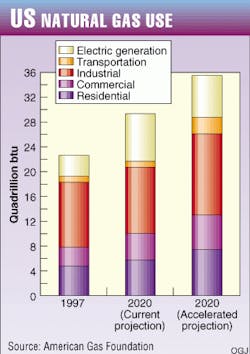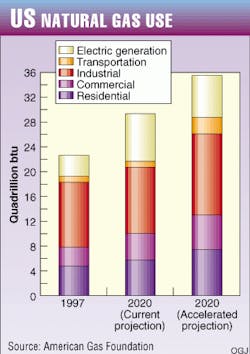Companies developing fuel cells and other technology aimed at increasing natural gas consumption will soon rival the "dot-com" internet companies as the sweetheart of investors, predicts Scott L. Campbell, president and a founding partner of Washington Policy & Analysis.
The consulting firm recently released a study for the American Gas Foundation (AGF) saying homeowners and businesses will use gas to generate electric power on site with fuel cells, microturbines, and reciprocating engines, accounting for roughly 20% of all new US electrical generation capacity.
Natural gas is abundant in the US, safe and reliable to deliver, more environmentally friendly than oil or coal, and nearly four times as energy-efficient as electricity from the point of origin to the point of use. Yet it supplies only a quarter of total US energy demand, because a national energy policy encouraging the use of natural gas has not been fully realized, says Campbell.
US consumption of natural gas could escalate more than 60% to 35 quadrillion btu (quads) by 2020, with residential and commercial markets accounting for nearly half of that increase, said AGF officials. The foundation's "accelerated" market forecast for 2020 exceeds current predictions of more than 29 quads and actual consumption of 21.9 quads in 1998, the latest available figure.
Gas market forecast
The accelerated market forecast is based on the assumptions that energy markets will be free and competitive and that natural gas utilities will be allowed "to compete fairly in these markets," the study said.
"...As gas markets are opened to competition, the balance between risks and rewards must be maintained for gas utilities. If this is not the case, gas utilities would be put at a serious market disadvantage, which would limit market expansion potential," the study concluded.
The accelerated market scenario has gas consumption by central-station power plants more than doubling by 2020. But that total consumption will be about 1 quad less than current projections as fuel cells enter the market.
By substituting gas for oil, coal, and other energy sources, total US energy consumption will be reduced by 6%, or about 7 quads, in 20 years, according to the study. That would include a reduction of 2.6 million b/d in oil consumption.
And because gas burns so much cleaner, it would reduce carbon dioxide emissions by 930 million tons/year. Use of compressed gas and LNG to fuel buses, trucks, and cars is expected to grow to about 1 quad by 2020 but will still account for less than 1% of the total vehicular market.
The study expects only modest increases in gas prices over the next 20 years, with wellhead prices remaining relatively constant at about $2.50/ MMbtu.
Technology effects
Producers also will use new technology to find and develop new North American gas reserves to supply that growing demand despite rapid depletion of current resources, said Dr. William Fisher, professor of geological science and interim director of the Bureau of Economic Geology at the University of Texas. Fisher was the only upstream representative on the advisory review panel for the study.
"Long-term trends in ever-increasing energy efficiency have put the United States at the threshold of a methane economy. With vigorous development and application of technology, the ample natural gas base of the nation can be converted to producible reserves at attractive costs and in volumes sufficient to meet a much-enlarged demand, thus allowing us to realize the tremendous benefits of a methane economy," said Fisher.
But that also depends on the industry's ability to gain access to some unexplored areas now banned by government moratoria, he said.
Fisher is confident that new gas supplies will be found in the US and Canada.
Coalbed methane, once considered uneconomical to produce, now accounts for 6% of US gas production, he noted.
A similar breakthrough on production of methane hydrates is possible in the future, according to the study.
But neither Fisher nor any of the other advisors addressed how the industry will fund research and development of new technology or the high costs of exploring the deep waters of the Gulf of Mexico, where much of the new reserves are likely to be found.
Despite fairly stable gas prices and a strong rebound in oil prices in the second half of 1999, there has not yet been a similar increase in drilling activity.
As a result, the oil field service sector, which has supplied much of the new upstream technology, is still suffering financially.
Producers also are competing with the new internet firms for investment dollars. As a result, some upstream experts question whether enough money and rigs will be available to supply growing gas demand in even 10 years, as they are forced to work harder to replace current depletion.



